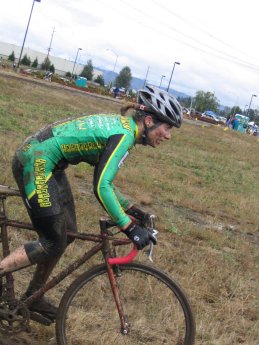How To Thoroughly Clean Your Bicycle in 6 Steps.
Posted by Matt Russ on 25th Jul 2019

There is clean, and there is spotless. When it comes to my bicycle I prefer the later. Cleaning your bike may or may not be a labor of love for you but there is an easy way to do it. Bike shops do a good job for the most part, but no one will give your bike as much TLC as you will.
A dirty drive train can rob 1-3% of your power and wears much faster costing your money over the long run. Over the years I have experimented with various methods of cleaning and degreasing my bike and I have finally come up with a system that completely removes the accumulated power robbing gunk. It is not the fastest method; but it is thorough and you will feel the difference. A bike stand will make the job a lot easier, and be sure to work in an area that can get a bit dirty. The run-off oil and grease can stain your driveway. You may want to note that the cleaning process I am going to recommend does not have to be performed each time you clean your bike but is more of a “deep cleaning” process to be performed periodically. Unless you ride in a very dusty area or your bike is extremely dirty, you may not need to be so thorough every time. A less involved cleaning process can be used between deep cleanings as long as it addressed drivetrain components.
Step 1- The Big Stuff. Start with a bucket of mild detergent (such as Dawn), rinse the bike thoroughly keeping the stream of water aimed downwards. You may want to remove your computer or other electronic devices. Never shoot a high pressure jet of water laterally at your bike or at any of the moving parts. When it comes to water the less you use the better. Use a small sponge to remove accumulated dirt, sports drink, and/or energy gel, then rinse again. Make sure you remove all surface dirt as you don't want to rub dirt into your paint job in the later steps.
Step 2- Clean Chain. Chain lubes are meant to be very sticky and they are hard to remove completely. I recommend a chain you can easily remove with a master link but for most this is a bit too technical. But removing the chain allows you to more thoroughly clean the chain, and once removed you have easy access to the drive train without having to work around the dirty chain. It also makes maintenance or repair of the drive train easier. Spray a small amount of WD-40 downwards onto your chain and sprockets as you slowly turn the crank. This will penetrate and lift the grease and oil, and make the next step a lot easier. Remove the chain and soak it for a few minutes in a mild degreasing solution. Agitate the solution or use an old tooth brush to help remove the accumulated chain lube and dirt, then rinse the chain. It should now be free of all dirt and old lubricant. Hang it preferably in the sun to drain and dry.
Step 3- Clean Drive Train. Spray the drive train components and cassette with a mild solution of degreaser and scrub the front chain rings, cassette, and rear derailleur pulleys until they are clean, then rinse. A drivetrain brush gets in all the cracks and crevices but an old tooth brush will work. You may hold the brush on the chain rings while turning the crank to make this go faster. Also clean all areas of accumulated gunk, such as your pedals and in-between your brake calipers. Make sure you do not leave any degreasing solution on your components for an extended period of time and use a product designed for bicycles. Some commercial degreasing solutions can harm your paint! Chain cleaning devices do a decent job but they almost always leave some dirt and lube on the chain, and can be a bit cumbersome.
Step 4- Clean/Lube Drive Train Components. Now that your drive train is clean you can take an extra step to lubricate it with teflon. Dry Teflon spray lubes have a solvent that cleans and leaves a teflon residue. This is good for spraying into the crevices of the moving parts of your bike and will blast out any remaining amounts of dirt, grease, and oil. These are designed to remove small particles and can be overkill if your components don't need it. Simply wipe off the excess teflon film when done. Do not spray teflon lubes directly into any sealed bearings (wheels, bottom bracket, derailleur pulleys) as the solvent will penetrate and break down their grease. Spray onto the working components of your pedals, brake calipers (not pads), and shifters. Using a small amount on a clean cloth, wipe your exposed cables down and spray into the ends of your cable housing. This in itself will make your bike shift more cleanly. Super Lube is also great for quick cleaning components in-between deep cleanings.
Step 5- Lube Chain. You can now put the chain back on. There are many brands and types of lubes on the market; wet, dry, ceramic, etc.. The most important thing is that you choose a lube designed for the conditions you ride in; such as wet/dirty conditions for a mountain bike. Wet lubes generally leave an oily residue that attracts dirt so don't use a wet lube unless you need it. Using a chain lube of your choice put a small amount on the TOP of each link. You do not need to lube the sides of the chain. Run the drive train around a bit and wipe of excess using a clean white cloth. An over lubed chain is a mess and will attract dirt. With a thorough chain cleaning you must ensure each link has a small amount of lube or you will get a “dry link.” This is usually indicated by a squeaking noise. You may want to wipe the chain down a second time after allowing it to sit overnight as the excess lube gravitates to the bottom of each link.
Step 6- Polish. It is now time for the detail. My favorite product (and easiest to work with) is a spray cleaner / polish designed for motorcycles and is carbon safe, There are several similar silicone based bicycle products but this one is my personal preference. I have been using this on my motorcycle for years and it is safe for all surfaces (except tires). Spray on a clean cloth and begin wiping your bike down from top to bottom. The great thing about this product is that if there are any remaining drops of lube or dirt it lifts it off and leaves a light protective film. You can also spray some on a rag to remove brake pad build up on your rims.
This is obviously not a 10 minute cleaning but once you get it down to a system it should take under an hour. Be sure to inspect all of your components for wear as you clean. An additional step would be to make sure your bolts are tight; especially at the stem and seat post / seat. Take it for a test ride and you will feel a noticeable difference in shifting and pedaling. A short ride also helps get rid of any water as does leaving it in the sun to dry. Deep cleaning your bike is a great pre-race ritual and helps identify issues and ensure against preventable mechanical failures. Treat your bike nicely and it will return the favor.


